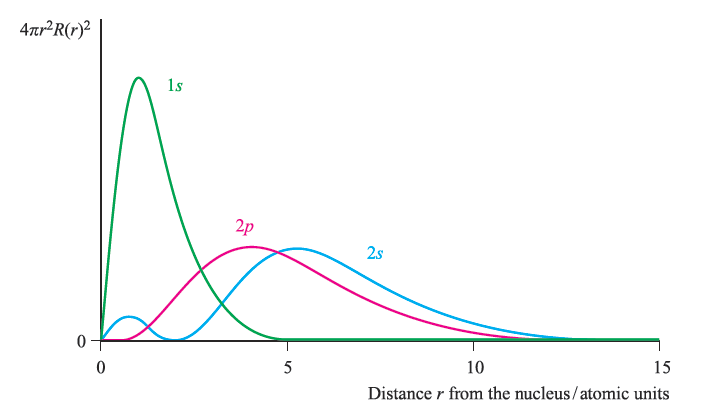
Penetration and shielding
 المؤلف:
CATHERINE E. HOUSECROFT AND ALAN G. SHARPE
المؤلف:
CATHERINE E. HOUSECROFT AND ALAN G. SHARPE
 المصدر:
Organic Chemistry
المصدر:
Organic Chemistry
 الجزء والصفحة:
p17
الجزء والصفحة:
p17
 11-2-2016
11-2-2016
 2856
2856
Penetration and shielding
Although it is not possible to calculate the dependence of the energies of orbitals on atomic number with the degree of accuracy that is required to obtain agreement with all the electronic configurations listed in Table 1.1, some useful information can be gained by considering the different screening effects that electrons in different atomic orbitals have on one another. Figure 1. shows the radial distribution functions for the 1s, 2s and 2p atomic orbitals of the H atom. (It is a common approximation to assume hydrogen- like wavefunctions for multi-electron atoms.) Although values of 4πr2 R(r)2 for the 1s orbital are much greater than those of the 2s and 2p orbitals at distances relatively close to the nucleus, the values for the 2s and 2p orbitals are still significant. We say that the 2s and 2p atomic orbitals penetrate the 1s atomic orbital; calculations show that the 2s atomic orbital is more penetrating than the 2p orbital.

Fig. 1 Radial distribution functions,4πr2 R(r)2 , for the 1s, 2s and 2p atomic orbitals of the hydrogen atom.
Now let us consider the arrangement of the electrons in Li (Z = 3). In the ground state, the 1s atomic orbital is fully occupied and the third electron could occupy either a 2s or 2p orbital. Which arrangement will possess the lower energy? An electron in a 2s or 2p atomic orbital experiences the effective charge, Zeff, of a nucleus partly shielded by the 1s electrons. Since the 2p orbital penetrates the 1s orbital less than a 2s orbital does, a 2p electron is shielded more than a 2s electron. Thus, occupation of the 2s rather than the 2p atomic orbital gives a lower energy system. Although we should consider the energies of the electrons in atomic orbitals, it is common practice to think in terms of the orbital energies themselves: E(2s) < E(2p). Similar arguments lead to the sequence E(3s) < E(3p) < E(3d) and E(4s) < E(4p)< E(4d) < E(4f ). As we move to atoms of elements of higher atomic number, the energy differences between orbitals with the same value of n become smaller, the validity of assuming hydrogen-like wavefunctions becomes more doubtful, and predictions of ground states become less reliable. The treatment above also ignores electron–electron interactions within the same principal quantum shell.
Table (1.1 )

 الاكثر قراءة في مواضيع عامة في الكيمياء اللاعضوية
الاكثر قراءة في مواضيع عامة في الكيمياء اللاعضوية
 اخر الاخبار
اخر الاخبار
اخبار العتبة العباسية المقدسة


